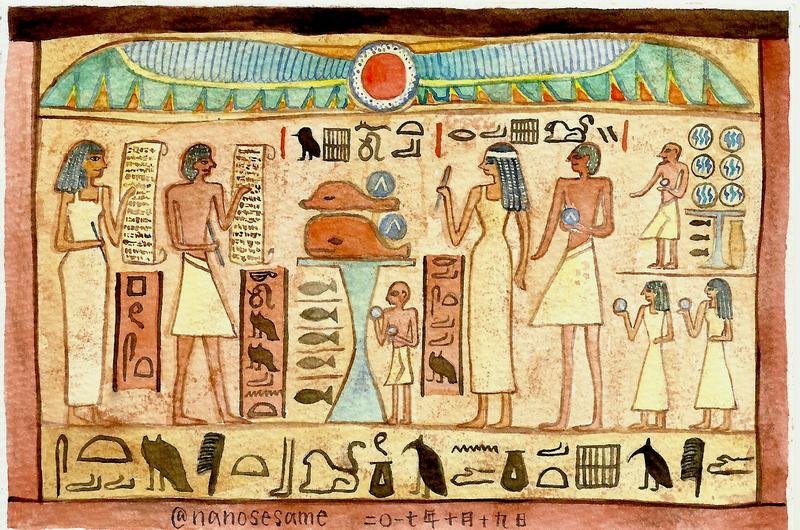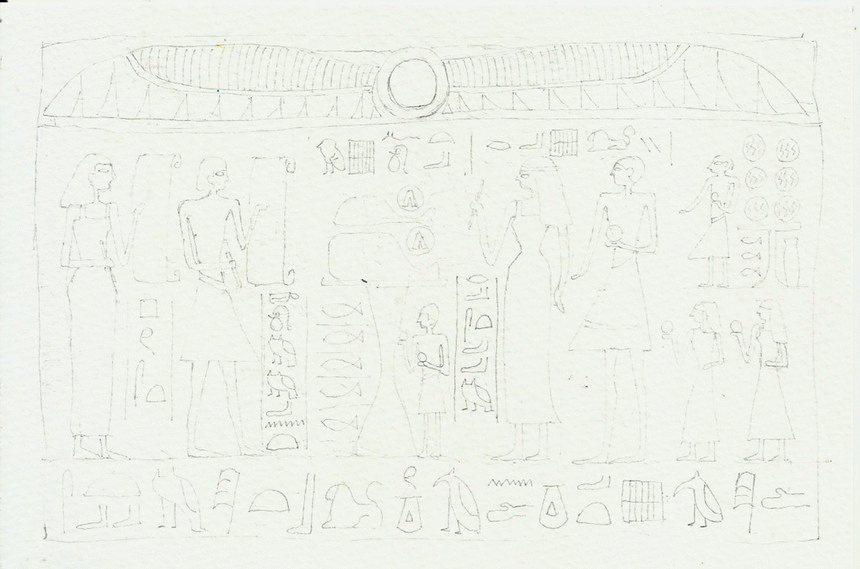
前天(18日)去看了在科學館和的《永生傳說—透視古埃及文明》展覧,最後一天很多人啊,大家都在衝最後一天吧?為甚麼要在最後一天才看,
就是木乃伊多放一天就古老一天嘛!
CP值最高就在最後一天了不是嗎?🤔
這次不單只有六位躺在大英博物館的木乃伊來到香港,還展出了200多件關於古埃及喪葬及生活的文物。對古埃及只有看尋寶電影認知的我,覺得這天真的看到很不得了的東西啊o
Last Wednesday (18th) I went to see the Eternal Life: Exploring Ancient Egypt exhibition at the Hong Kong Science Museum. It was the last day of the exhibition, many people like me were the "deadline fighter" that rushed to see. Why did I go on the last day? BECAUSE THE MUMMIES WERE OLDEST ON THAT DAY, ISN'T IT? 🤔 In this exhibition, six mummies from the British Museum were shown. Also, 200 objects were demonstrated. From the exhibition, I gained a new insights into the ancient Egypt.

Outline 起稿

在其中幾位的泥紙棺上有很多漂亮的繪畫紋飾。還有其他石碑畫展品都很吸引我。所以我也來畫一下吧!不過內容變成了我們現在的生活,就是每天寫文點讚回覆,哈!
Some of the cartonnage cases have very beautiful painting and pattern. Stelae also attracted my attention. Therefore, I would like to draw one describing the life on Steemit :P

因為之前颱風閉館了,科學館為此延長了最後幾天的展覧時間到晚上九時。當天下午四時多趕到,售票處就是人龍,等了大概二十分鐘左右。因為是星期三特價日,所以原本要HKD30 的票10元就OK了,不過就算30也是很佛心的價格啊。
一進去已經有一種神秘的氣氛,這個展覧的燈光是由頭暗到尾的,有些位置黑得不安,應該是為了保護木乃伊的措施吧?展覧是可以拍照的,不過不可以用閃光燈。所以,也就變成了木乃伊當模特的拍照大會了xDDD (木乃伊的心情可能是崩潰的)
Because of the typhoon and closed before, the museum extended the open hour to 2100 of the last 3 days. I arrived around 1600, there were a long queue in front of the ticket counter. Waited for around 20 min, I got the ticket by HKD10. This is the every Wednesday special offer, normal is HKD30 (Well, HKD30 is also touching price in the city, just around USD3.8). The entrance and the exhibition were dim, I guest it is for the protection of the mummies. Photo is allowed in the whole exhibition. So... it was a big shooting events and the models are mummies xDD

Coloring 上色

這次由背景開始。在要不要把非背景部份也先上色的問題糾結了一下,因為他們圖畫是畫在底色是泥黃的石碑上,按理應該都有淺啡作底色。但先不管了,之後再填上,還是先把背景定下。
Start from background. I was not sure whether I should paint a layer of brown on the whole paper because the stela are stone in yellow brown. Finally, I left it and paint later.

在其中一個展品得知,他們會把男人塗上紅色的做法,所以我也把男性的身體用上比女性的深紅一點。
According to the description of one of the objects, they would paint the body of males with red/red brown, so I also used a darker reddish brown for the males.

在這裡簡單介紹一些注目的展品吧。這是名叫《來自底比斯的已婚婦人—內斯達華狄特》的女性木乃伊(約公元前700-680年),她是一位有錢的婦人,棺木也是展品中最講究的一個。由內至外有四層,首三層是棺本。
在只有X光的60年代,考古人員只能從不太清晰的X光相和分析,而內斯達華狄特這個名字和棺本上的文字也沒有明確表明是女性。所以,在數年前大英博物館引入電腦斷層掃描技術前,她一直被誤會為一名男性呢。
左上是以她由死後到經過一連串神明的考核,最後到達永生之地的動畫。其中一節是她要把心臟放天秤上,對面是一根羽毛。如果心比羽毛重,就代表不合格,不能得到永生,還要死第二次@@ 古埃及人認為靈魂是在放心臟,所以製造木乃伊時把所有內臟都抽掉,唯保留心。
The first real mummy I met was Nestawedjat, a married woman from Thebes (about 700-680BC). The style and quality of the cases indicated that she was from a wealthy family. It has four layers and the first three layers are cartonnage cases. In the 1960's, there was only not very clear X-Ray photo to identify the mummy. The cases painting and names written provided limited information. As a result, until the British Museum used the latest Computerized Tomography (CT) scanning to study the mummies. Nestawedjat was misclassified as a male. The upper-left was an animation of Nestawedjat after death and the journal to the eternal world. A scene that she needs to put her heart on the scale and the opposite is a feather. If her heart is heavier than the feather, she will fail the test and die again. The ancient Egyptian believed that heart contains the soul of human. During the process of making mummy, all organs were taken out but the heart.

第三位(下)是《來自阿克明的祭司—艾爾都奴》(約公元前600年)。他也是一位祭司,所以也擁有著精美的棺木。而特別的是他有一副塗金面具,為了永生時也有美麗的面孔。而金在古埃及象徵神的皮膚,何其神聖和珍貴。
The second one is Tamut, a Chantress of Amun (about 600BC). Her father was a priest of god Amun, the god of the gods. As a daughter from a high-states family, her coffin was made good quality, and amulets and ritual trappings placed with her body. This could protect her on the way to the world after death and long life.
The third one is Irthorru, a priest from Akhmim. He was a priest, therefore, his coffin was also well made. The most special thing is his gilded mask. It means that he could have a perfect face forever. Gold represents god's skin, so you could imagine how important it is.

第四位(上)是《來自底比斯的神廟歌手》(約公元前800年),她是阿蒙神廟的歌手,名字不詳,只知道她已婚。女祭司和神廟歌手的喪葬用品選擇上,都以年輕和精緻為主。所以在她這部份展區也放了不同的手飾和飾品。
第五位(左下)是一位來自哈瓦拉的小童木乃伊(約公元40-60年)。塗金泥畫棺木表示了他應該來自富裕家庭。而在古埃及為小童做木乃伊是很少見的,不過在羅馬時期這種做法開始增加。
最後一位(右下),是來自羅馬時期埃及的年輕男子木乃伊(約公元140-180年),在展品中最年輕的。在羅馬統治時期仍有製作木乃伊的習慣。而這時的一種新設計,是在木板上畫上死者的肖像。
這雙眼水汪汪的男生只有17至20歲左右,而分析顯視他有過重的問題,在肖像畫看不出來啊!
The forth one is A Temple Singer from Thebes (about 800BC). She was also a priest, a priest singer. Her name is unknown. The only thing we know is that she was married. Female priest and temple singers tended to choose young funerary equipment and delicated jewellery. This exhibition area also shows pretty accessory and beautiful tools, stelae and crafts.
The fifth is A Young Child from Hawara (about AD40-60). His gilded and well decorated cartonnage mask tell us that he might come from a wealthy family. It was not common to mummify children in ancient Egypt. However, this practice increased during the Roman period.
The last one is A Young Man from Roman Egypt (about AD140-180), the youngest one among six. In the Roman Egypt period, the making of mummy was still existing. The new design of coffin was attaching a "mummy portrait" on the mummy. This young man with beautiful eyes died at around 17 to 20 years old. According to the study, he had the problem of overweight. Wait! It doesn't shown on the portrait!

Props 道具

原來啊,比較上層的階級,他們都會束短髪或剃光頭,然後戴上另外編製的假髮。用料是真髮、羊毛或者纖維,而當中真髮是最貴的。
Didn't know it before. The ancient Egyptian fashion was wearing wig. The wigs were made by real hair, wool and fiber, and the human hair was the most expensive.

上面有不同的小小元素代表在STEEMIT上的活動。我就不直接說,嘻:P
There are some elements represent activities on Steemit. I left it for readers :P

我加了一個邊框,這是來自其中一塊我很喜歡的石碑展品,在遊記中看看圖片吧。而在最頂的翅膀則是參考了木乃伊底比斯伊神廟歌手的泥紙棺紋飾,這展區的展品集中於美妝和首飾,看得很開心^^
I added a frame. This is from one of my favourite stela. The wing is referenced from the Temple Singer from Thebes mummy. This section focus on beauty and accessory, I enjoyed this very much^^ There was an ancient Egyptian hieroglyph learning corner. I tried to draw this, so the hieroglyph on the illustration is readable :) However, the translation of E, I and Y are different from the resources I found on Internet, don't know why. :-| Lastly, I used the cosmetic puff to add some texture and make it looks like a stela.

在圖畫上的古埃及文是在展覧的學習區看到的,不過回來搜查時,看到發音相近的字母E、I 和Y跟網絡上找的不同,不知道是不是年代不同還是翻譯的規格不同呢。 最後用化妝棉印上紋理來一點「石碑」的效果。

除了木乃伊還有很多精彩的展品,就抽出幾個我很喜歡的和在這插畫中參考過、得到靈感的文物吧!
上面是在前面提過的神廟歌手區的其中一個展櫃。立體頭像展示了戴了假髮的模樣。而下面的是剃刀、鉗子和梳等。右邊是我最喜歡的一塊石碑,叫丹瑤恩康素墓碑。丹瑤恩康素墓碑是一位歌手,正在向神祗奉獻食物和鮮花,她的時期和神廟歌手木乃伊相近。
她的半透明裙子真在太可愛了!構圖和內容都很時尚(掩面)這邊框也是用在插畫上的那個(大愛)
Besides the mummies, there were many brilliant ancient objects shown. I choose some of my favorites and those I referenced here. Above one is from the area of Temple Singer. The 3D view of a Egyptian wearing wig. The front are shavers, tweezer and comb. The stela is called Funerary stela of Deniuenkhonsu. The famale singer, Deniuenkhonsu lived in the same period as the Temple Singer. The semi-transparend dress is so pretty. She is offering foods and flower to the god Ra-Horakhty-Atum. Pay attension to the frame which I used in the illustration <3

左邊是祭司艾爾都奴區的展品,叫《科的石碑》。最上部份是喪葬祭司在供奉冥王歐西里斯。中間是科和妻子在接受兒子的祭品。這場景我轉化成為插畫「STEEMIT活動考」。
右邊是幼童木乃伊區的《伊圖與亨奴吐雷和兒子的石像》。我走過去看時只有看到側面的兩個大人,然後繞到正面發現還有個小朋友在中間,有點...嚇到了。這裡可以比較清楚看見男性的紅色皮膚。
The left one is "Stela of Qeh" from the area of priest, Irthorru. The upper part shows the priest is offering Osiris. The middle part is Qeh and his wife receiving offers from his son. I turned this into my idea of the "Steemit Activities". The right one is from the young child mummy area, called Group statue of Itu and Henutweret with their son. I saw it from the side view first and only saw only the adults. When I went to the front I was shocked by the little child in the middle. This stela shows the red skin of using red color for male skin.

Epilogue 後記


在離開文物展館後,還有互動學習區。右上那部就是傳說中把內斯達華狄特誤會糾正過來的斷層掃描機了。另外例如有埃及智力棋試玩區;金字塔搬運力學原理實測,好像是斜度低的那邊比較好拉,還有一個垂直的,完全拉不動;還有名字創作和互動餐桌,上面有食物的模型,放到桌上會出現該種食物在古埃及食桌文化中的相關資訊。
我很喜歡這些展後活動,大人和小朋友都能體驗和運用在展覧看過的知識,最重要是提高和培養小朋友對各種文化展覧的興趣。
Leaving the main exhibition area, there was the interactive learning area. The scanner which reveal the truth of Nestawedjat. The chess game of ancient Egyptian; experiment of pulling blocks of the pyramid; making your ancient Egyptian name and interactive table. Placed the food models on the table and information of the food in ancient Egyptian period would pop up. I like this kind of learning area because both adults and children can enhance the knowledge and memory of exhibition. Moreover, the children looks excited. I think it can develop their habit and interest of visiting different kinds of exhibitions.
























